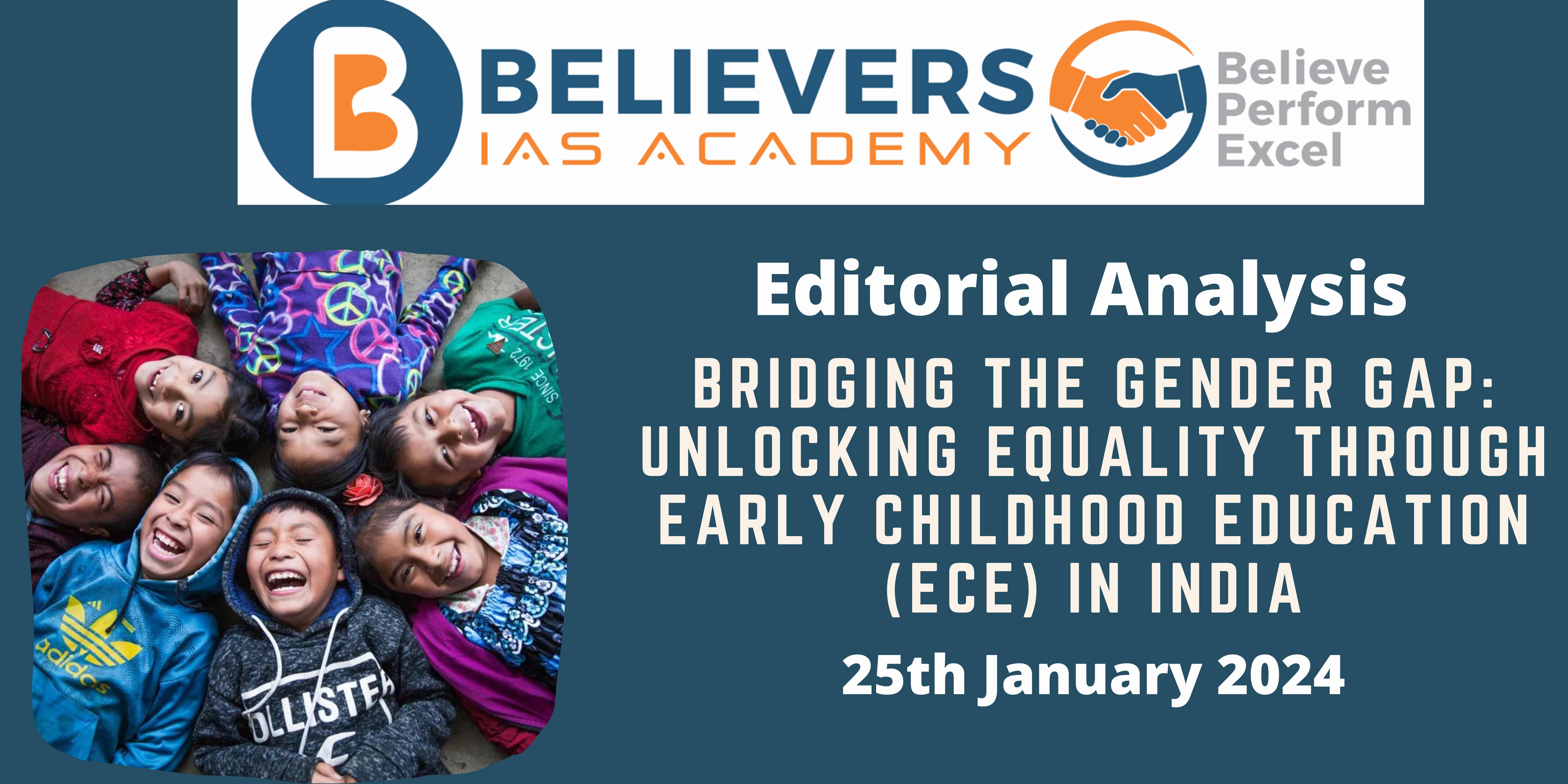Bridging the Gender Gap: Unlocking Equality through Early Childhood Education (ECE) in India
Context:
The Annual Status of Education Report highlights a concerning gender gap in STEM course enrollment, with boys outnumbering girls. In this editorial analysis, dated May 17, 2020, Sarah Iype delves into the intricacies of gender-related disparities in educational attainment, emphasizing the need for a concentrated effort in early childhood education (ECE) to eradicate deep-rooted gender biases.
Mains Question:
Critically analyze the gender gap in educational attainment, emphasizing the role of early childhood education (ECE) in addressing deep-rooted biases. (250 words)
Role of Early Childhood Care and Education (ECCE) in India:
- Early childhood, encompassing the first six formative years of life, holds paramount significance for an individual’s rapid growth and development.
- India, with approximately 158.7 million children aged 0-6 years, recognizes the importance of catering to this population segment.
- The nation, a signatory to the Convention on the Rights of the Child and Education for All, emphasizes ECCE as a primary goal.
- Scientifically validated, ECCE plays a pivotal role in breaking the intergenerational cycle of disadvantages, fostering long-term social and economic benefits.
Constitutional and Legal Foundations for Early Childhood Care and Education (ECCE) in India:
- Examining the constitutional and legal provisions, Article 45 of the Directive Principles of State Policy emphasizes the State’s endeavor to provide ECCE for all children up to the age of six.
- The Right to Education (RTE) Act reinforces this commitment by providing for free pre-school education.
- These legal frameworks underscore the nation’s commitment to ensuring early childhood care and education.
Policy Measures Shaping Early Childhood Care and Education (ECCE) in India:
- The National ECCE Policy (2013) outlines a vision for holistic child development, focusing on care and early learning. Acknowledging various service delivery models, the policy aims at universalizing ECCE, ensuring equity, improving quality standards, and enhancing capacity through coordination and convergence.
- Other policies, including the National Policy for Children (1974), National Policy on Education (1986), National Nutrition Policy (1993), 12th Five-Year Plan, and National Education Policy 2020, contribute to the comprehensive approach to ECCE.
Schemes and Programs Fostering Early Childhood Care and Education (ECCE) in India:
- The Integrated Child Development Scheme (under Saksham Anganwadi) and Poshan 2.0, alongside PM-POSHAN and the National Health Mission, represent significant government initiatives.
- These programs aim to enhance the nutritional and health status of children aged 0-6 years, providing services such as supplementary nutrition, non-formal education, immunization, and hot cooked meals.
- These schemes collectively contribute to creating a supportive environment for early childhood development in India.
Dimensions of the Article:
- Parity in Learning Outcomes
- Worsening Educational Attainment Gap
- Gender Disparities in Early Childhood Education
- Urgent Focus on Early Childhood Education (ECE)
Parity in Learning Outcomes:
- Contrary to widespread beliefs, a comprehensive examination of learning outcomes, as demonstrated by the National Achievement Survey (2017), reveals gender equity.
- Test scores across elementary and secondary classes exhibit nearly identical performance for boys and girls.
- However, this apparent parity masks the subtler gender discrimination prevalent in the educational landscape.
Worsening Educational Attainment Gap:
- Educational Attainment Trends: Despite girls achieving higher education levels, the gender gap in educational attainment has worsened over two decades. The mean years of schooling for girls nearly tripled from 1.7 years in 1990 to 4.7 in 2018. However, the gender gap increased from 2.4 years to 3.5 years, diverging from global trends where gender gaps narrowed.
- Progressive Gender Gap: As education advances, the gender gap widens due to societal norms and stereotypes. Barriers escalate for girls, leading to higher dropout rates, particularly noticeable by Class 8, highlighting a concerning trend.
Gender Disparities in Early Childhood Education:
- Roots of Discrimination: The genesis of gender discrimination emerges in early childhood education (ECE). The Annual Status of Education Report “Early Years” underscores a significant gender difference in enrollment, with more boys enrolled in private institutions. Societal biases dictate girls’ enrollment in free government schools, showcasing ingrained gender prejudices.
- Age-Related Disparities: A five percentage point gender difference in enrollment at the age of four increases to eight percentage points by eight years. Cultures valuing male children’s education witness more girls being withdrawn from school, highlighting the connection between cultural beliefs and educational choices.
Urgent Focus on Early Childhood Education (ECE):
- Policy Implications: The pivotal shift must target early childhood education to eradicate gender gaps at their roots. ECE, occurring between ages three and seven, shapes children’s perceptions of gender roles. Addressing biases in this formative stage is crucial for eliminating long-term disparities.
- Challenges in ECE: Inadequate regulatory frameworks, insufficient funding, and a lack of legislation for universal ECE pose challenges. Urgent attention is needed to overcome these bottlenecks and establish the foundations for an unbiased education system.
- Benefits of ECE Investment: Longitudinal studies demonstrate that every dollar invested in ECE yields significant returns, emphasizing the economic and societal benefits. An actionable roadmap, coupled with increased funding, can leverage existing initiatives like Beti Bachao, Beti Padhao, and the Draft National Education Policy to champion universal ECE.
Way Forward:
- The imperative is to act swiftly, focusing on ECE to eliminate entrenched gender biases. A concerted effort is needed to provide universal enrollment in ECE and ensure that preschools play a pivotal role in erasing gender stereotypes.
- The ongoing discourse on the multiple benefits of girls’ education, from poverty reduction to improved economic development, reinforces the urgency to augment social capital for a gender that shapes the future.




